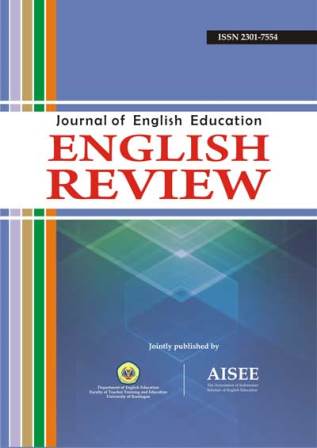CONTENT AND LANGUAGE INTEGRATED LEARNING (CLIL): AN EXPERIMENTAL STUDY ON CLIL COMPATIBILITY WITH THE MODERN GREEK EDUCATIONAL SYSTEM
Abstract
This paper focuses on the Content and Language Integrated Learning (CLIL) method for (foreign) language teaching. The CLIL approach is rapidly gaining momentum across Europe and all over the world. It is the result of recent European Union efforts to develop and apply innovative educational practices of interdisciplinary character in order to bridge the gap between foreign language education and optimum learning outcomes. In order to investigate the compatibility of CLIL with the contemporary Greek educational reality, a small-scale experimental research study was set up, including the development of original e-learning material, a pilot class instruction based on this material and the evaluation of the results. The class instruction was based on Project-Based Learning whereas Collaborative Learning was supported by the Edmodo e-learning platform. Information on the progress of the pilot class instruction and the learning outcomes achieved was disseminated through a wiki set up for this task.
Keywords: CLIL, interdisciplinarity, plurilingualism, multiculturalism, assessment, Information and Communication Technology (ICT)References
Anderson, L., Kratwohl, D., Airasian, P., Cruikshank, K., Mayer, R., Pintrich, P., Raths, J., Merlin, C., & Wittrock, M. (2001). A Taxonomy for Learning, Teaching, and Assessing: A revision of Bloom’s Taxonomy of Educational Objectives. New York: Longman.
Barbero, T. (2012). Assessment tools and practices in CLIL. In Assessment and Evaluation in CLIL.
Barbero, T. & Maggi, F. (2011). Assessment and Evaluation in CLIL, in Marsh D., Meyer O., Quality Interfaces, EAP. Eichstätt: Eichstaett Academic Press UG
Bloom, B. S. (ed.). Taxonomy of Educational Objectives. Vol. 1: Cognitive Domain. New York: McKay, 1956.
Coyle, D., Hood, Ph., & Marsh, D. (2010). CLIL, Content and Language Integrated Learning. Cambridge: Cambridge University Press.
Cummins, J. (1984). Bilingualism and Special Education: Issues in Assessment and Pedagogy. Clevedon: Multilingual Matters.
Cummins, J. (2000). Language, Power and Pedagogy. Clevedon: Multilingual Matters.
EUR-Lex (Access to European Union law). Communication from the Commission to the Council, the European Parliament, the Economic and Social Committee and the Committee of the Regions - Promoting Language Learning and Linguistic Diversity: an Action Plan 2004 – 2006. Retrieved from the web address: http://eur-lex.europa.eu/legal-content/EN/TXT/?uri=CELEX:52003DC0449
European Comission. (Eurydice network). (2008). Key Data on Teaching Languages at School in Europe. Retrieved from: http://eacea.ec.europa.eu/about/eurydice/documents/KDL2008_EN.pdf
Eurydice. (2006). Content and Language Integrated Learning (CLIL) at School in Europe. European Commission. Retrieved from: http://www.indire.it/lucabas/lkmw_file/eurydice/CLIL_EN.pdf
Ioannou, S., & Pavlou, P. (2011). Guidelines for CLIL Implementation in Primary and Pre-primary Education.
Kilpatrick, W. H. (1918). The project method. Teachers College Record, 19, 319-335.
Krashen, S. (1981). Second Language Acquisition and Second Language Learning. Retrieved from the web address: http://www.sdkrashen.com/content/books/sl_acquisition_and_learning.pdf
Laevers, F. (2005). (Ed. in collaboration with: Mieke Daems, Griet De Bruyckere, Bart Declercq, Julia Moons, Kristien Silkens, Gerlinde Snoeck, Monique Van Kessel) Well-being and Involvement in Care Settings. A Process-oriented Self-evaluation Instrument. Kind & Gezin and Research Centre for Experiential Education. (Manual: http://www.kindengezin.be/img/sics-ziko-manual.pdf)
Llinares, G. A. (2005). An introduction to CLIL. Presentation at Cracow European Language Label Conference
Llinares, A., Morton, T., &Whittaker, R. (2012). The Roles of Language in CLIL. Cambridge: Cambridge University Press.
Marsh, D. (2002). Content and Language Integrated Learning: The European Dimension - Actions, Trends and Foresight Potential. DG Education & Culture, European Commission.
Maljers. A., Marsh, D., Coyle, D., Hartiala, A.K., Marsland, B., Pérez-Vidal C., &Wolff, D. (2002). The CLIL Compendium.
Mavromara, L. A. (2010). The Pedagogy of Project-based Learning (Project method) and its application in the teaching of a foreign language - language specialty. PI Inspection of Educational Affairs, 17.
Mehisto, P. (2008). CLIL counterweights: Recognizing and decreasing disjuncture in CLIL. International CLIL Research Journal, 1(1), 93-120.
Mertler, C. A. (2001). Designing scoring rubrics for your classroom. Practical assessment, Research & Evaluation. Retrieved from: http://pareonline.net/getvn.asp?v=7&n=25
Ministry of Education. (2002). Cross Curriculum Framework (DEPPS) and Curricula (A.P.S.) of Compulsory Education. Volume I. Athens: Ministry of Education - Pedagogical Institute.
Mohan, B. (1986). Language and Content. Massachussetts: Addison-Wesley Publishing Company.
Mohan, B., & Van, N. M. (1997). Understanding cause-effect: Learning through Language. Forum, [Online] 35 (4).
Quartapelle F. (2012). AICLE/EMILE. Retrieved from: http://www.aeclil.net/
Sanz, C. (2000). Bilingual Education Enhances Third Language Acquisition: Evidence from Catalonia. Applied Psycholinguistics, 21: 23-44.
All articles published in English Review: Journal of English Education (ERJEE) are licensed under the Creative Commons Attribution 4.0 International License (CC BY 4.0).
Copyright Ownership
Authors retain the copyright of their articles and grant ERJEE the right of first publication. The journal is granted a non-exclusive license to publish, reproduce, and distribute the article in any format, medium, or platform, provided that proper credit is given to the original authors.
License Terms – CC BY 4.0
Under the Creative Commons Attribution 4.0 International License, others are free to:
- Share — copy and redistribute the material in any medium or format
- Adapt — remix, transform, and build upon the material for any purpose, even commercially
As long as they:
- Provide appropriate credit to the original author(s) and source
- Provide a link to the license (https://creativecommons.org/licenses/by/4.0/)
- Indicate if any changes were made
There are no restrictions on the reuse, reproduction, or adaptation of published articles as long as attribution is properly given.
Author Warranties
By submitting a manuscript to ERJEE, authors confirm that:
- The work is original and does not infringe any existing copyright.
- The manuscript has not been previously published and is not under consideration elsewhere.
- All sources and references are appropriately acknowledged.
- Necessary permissions have been obtained for any copyrighted materials used.










